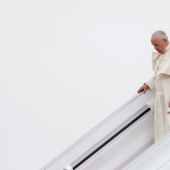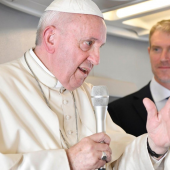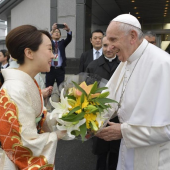One of Pope Francis' favorite words is "periphery." His words are but a reflection of his thoughts and sentiments that he does not fail to translate into action. This is reflected in his apostolic visits and his appointments.
The man who shepherds the global Catholic Church has a deep concern for the periphery. He has his gaze again set toward Asia.
Pope Francis will visit Thailand and Japan in November 2019. Thailand would be the sixth and Japan the seventh Asian country he would be visiting.
In this piece we take a quick look at the five Asian visits he has made.
South Korea
South Korea was the first Asian country Pope Francis chose to visit. He came in August 2014 on a five-day visit on the occasion of the Sixth Asian Youth Day.
On his arrival in Seoul, the South Korean capital, Francis was greeted by President Park Geun-hye of South Korea.
Speaking at the Presidential Office in Seoul, he said" "I came here thinking of peace and reconciliation on the Korean Peninsula."
Later, Francis held a private meeting with the families of victims of the MV Sewol ferry disaster.
Francis held the first public Mass of his trip on August 15 in front of a 50,000-strong crowd at Daejeon World Cup Stadium where he asked the Koreans to "reject inhumane economic models which create new forms of poverty and marginalize workers."
He later made a speech in English, his first as pope.
He beatified the first generation of 124 Korean Martyrs in Gwangwhamun Square before an estimated 800,000 people on August 16.
Pope Francis concluded his five-day visit with a Mass for peace and reconciliation of the divided Korean peninsula in Seoul's Myeongdong Cathedral.
Sri Lanka
Pope Francis visited Colombo, Sri Lanka, on January 13 - 15, 2015.
At the sea-front Mass by the beach in Colombo, Pope Francis canonized the nation's first saint, the 17th Century missionary Joseph Vaz.
The pope urged the people to follow the example of the saint who showed the importance of transcending religious divisions, emphasizing that genuine worship of God bore fruit not in violence or hatred, but in respect for the sacredness of all life.
It was a message that struck a chord with many, after 26 years of fighting and tensions between the majority Sinhalese and the Tamil minority until the conflict ended in 2009.
After the Colombo Mass, Pope Francis travelled to Madhu in the north, a region that saw some of the fiercest fighting in the war.
In a prayer at a local shrine, he said: "We ask also for the grace to make reparation for our sins and for all the evil which this land has known."
More than one million Sri Lankans (about seven percent) are said to be Christian, most of them Catholic. They include both Sinhalese and Tamils. About 70 percent of Sri Lankans are Buddhist, with 13 percent Hindus and 10 percent Muslims.
The last papal visit to Sri Lanka was 20 years ago, when Pope John Paul II was boycotted by Buddhist leaders. Pope Francis, however, met a group of Buddhist, Hindu, and Muslim leaders, urging reconciliation.
In keeping with his message of unity for Sri Lanka, Pope Francis urged its citizens to follow the example of Joseph Vaz and learn to overcome religious differences.
Philippines
Pope Francis made a state visit to the Philippines from January 15 to 19, 2015. He drove to the Malacanang Palace to meet then-president Benigno Aquino III. He was the third pontiff to visit the Philippines after Paul VI and John Paul II.
The theme of Francis' Philippine visit was "Mercy and Compassion."
Besides Manila, he visited Tacloban and Palo, Leyte, to encourage the victims of super typhoon Haiyan (Yolanda).
The Filipinos nicknamed Francis Lolo Kiko ("Grandpa Francis") as a term of endearment, which he commended.
The pope traveled to Tacloban where he celebrated a Mass and had lunch with survivors of the typhoon. He also blessed the Pope Francis Center for the Poor that was completed in December 2014.
The pope held a brief meeting with religious leaders. His visitation was cut short due to the brewing tropical storm Mekkhala.
Pope Francis also celebrated a Mass at the Manila Cathedral, attended by bishops, nuns, priests, seminarians, and about 500 lay people.
Before the Mass, the pope and Cardinal Luis Antonio Tagle met with some street children supported by the Tulay ng Kabataan Foundation.
Pope Francis also met with representatives of other religions, after which he also met with about 24,000 youth representatives at the University of Santo Tomas.
The concluding Mass for the pope’s visit was held at Quirino Grandstand in Luneta Park, the same venue of Pope John Paul II’s World Youth Day Mass 20 years ago.
This Mass was open to the general public and witnessed a massive turn out of over six million people, making it the largest Mass during a papal visit.
The people sang the World Youth Day Anthem "Tell the World of His Love" and the theme song for the Pope’s visit "We Are All God’s Children."
The pope’s visit definitely touched the Philippines in a true spirit of mercy and compassion.
The pope’s Apostolic visit was in order to console the victims of the super typhoon, which was the strongest typhoon to make landfall in history.
Pope Francis had also wanted to visit the Philippines as his predecessor was unable to do so. In the spirit of mercy and compassion, the pope’s visit touched the hearts of many, especially the victims of Haiyan.
Myanmar
Pope Francis visited Myanmar between from Nov. 27 to 30, 2017. He was the first pope to visit Myanmar.
His visit included a trip to the capital city of Naypyidaw where he met with government officials, including Htin Kyaw and Aung San Suu Kyi.
On the 29th, the pope celebrated a public Mass at the sprawling Kyaikkasan Ground in Yangon. He also met the bishops of Myanmar and the clergy.
The pope held a meeting with the Sangha, the Supreme Council of Buddhist monks.
Before his departure for Bangladesh, the pope celebrated a Mass for the youth at St Mary’s Cathedral in Yangon.
During his homily he exhorted the young people to be courageous witnesses and bearers of the Good News.
"Indeed, the young people of Myanmar are the 'good news' for they are the concrete sign of the Church’s faith in Jesus Christ who bring us joy and hope that will never die," he said.
Bangladesh
Pope Francis’ visit to Myanmar was followed by a trip to neighboring Bangladesh from Nov. 30 to Dec. 2.
He held a public Mass and visited various sites such as the Bangabandhu Memorial Museum and the local Mother Teresa House, and met with President Abdul Hamid of Bangladesh and other government officials.
The theme of his visit was "Harmony and Peace."
Pope Francis also attended an interfaith meeting where he met with members of the Rohingya community.
Pope Francis’s visit to Bangladesh "was a celebration of our cultural identity, of harmony, of diversity, and peace," said Patrick D’Rozario, archbishop of Dhaka and Bangladesh’s first cardinal.
The predominantly Muslim country has a population of only about 350,000 Catholics.
"The pope brought an active presence of Jesus Christ, through his presence, through his love, compassion and openness to everyone, his encompassing attitude to culture and religions. It touched a deep cord in everyone in Bangladesh," said Cardinal D’Rozario.
"The Christians in particular were very, very happy," he said. "They got to see the pope close up at all of the four big events, and so many could - unexpectedly - touch the pope, and this for them was a blessing and grace-filled moment."
Now it is the turn of the people of Thailand and Japan who wait eagerly to meet Pope Francis and to hear of the Mercy and Compassion of the Father and be enthused by the Joy of the Gospel.
Father George Plathottam








